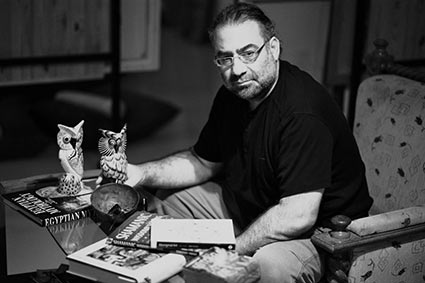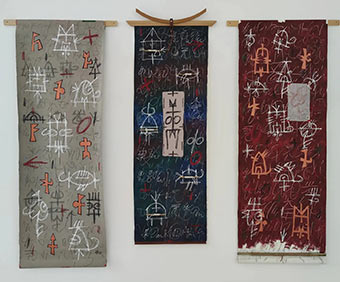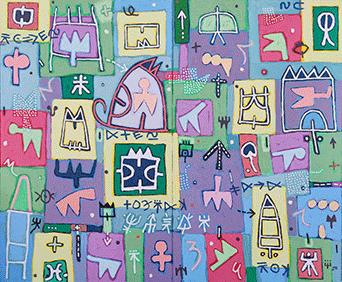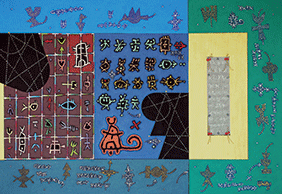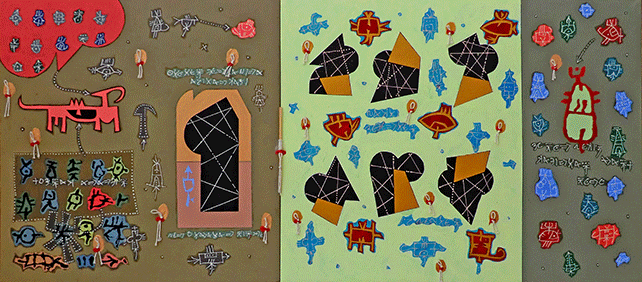MEMORY AND PRESENCE
Umit Inatci’s body of work is governed by a strong symbolism, which alludes to archetypal forms. Beyond any socio-political circumstances or situations and against any kind of power, the artist invents his own alphabet of signs, which serves as a personal language, having its own codes and accessible only after an initiation. In the installation Memory and Presence, the artist writes on a blackboard using white colour these exact personal symbols, which allude to an ancient undeciphered script. He combines them with other symbols in blue and red colour, like arrows, cross-shaped figures or vestigial geometrical forms.
Besides any references to the history of art and the use of a black background – from Kazimir Malevich to Ad Reinhard – it seems that in Umit Inatci’s work the basic insinuation is made on the blackboard, on the black board on which the pupils used to learn how to write before the introduction of copybooks and long before the boards were painted green. Malevich’s pure clarity and the spiritual element or the absolute void beyond Ad Reinhard’s mystified allusions are not characteristics of Umit Inatci’s art, which is rife of symbols and references to the relationship between past and present. The blackness of the board expresses the basis of the primordial chaos out of which emerged the first instances of articulation, and writing of a potentially understandable speech. The cryptographic personal symbols of the artist allow him to ‘hide’, to get away from legible symbols or everyday problems, to indulge more in ancient and panhuman socio-political and philosophical questions. Thus, he creates a secret language within the language itself, which functions as an escape from a reality that hurts.
The installation is completed with a small table on which the artist writes signs of his personal alphabet on a white background. The three-dimensional still life is completed with the skull of a native Cypriot ram as a sacrificial animal, and a ball made up of white stout leather bands with many knots. Knots are representing a momentum of cosmic coincidence. At the four legs of the table the artist has tied unprocessed branches of wood. Besides an initial surprise the viewer may feel towards this weirdcomposition of materials, which has nothing to do with the artist’s aesthetic intentions and which would, in some ways allude to materials of Arte Povera, the whole installation of Umit Inatci takes a special form. Because, in essence, this is a kind of an improvised ‘magic graft’, which the artist uses with the utopian desire to give back to the wood its former natural life, abolishing in this way the contrast between nature and culture. The dry branches of wood serve as intermediate, improvised instruments of a magical function. Consciously, the artist talks about a kind of shaman (animist) intention, which characterises his creative process and comes in contrast with a more rationalistic classification one can see in other of his works, like, for instance, in those with the dividing vertical and horizontal lines, which resemble a chess board. One could say that Umit Inatci introduces disorder to Piet Mondrian’s “grille/grid” and re-interprets that of Paul Klee.
The classification, the filling of the pictorial surface to the point of saturation offers a kind of security to the feeling of insecurity that may be created by the void. If, as Aldo Iori states, “the grid becomes increasingly an organising element in the equilibrium of the pictorial page and within it there is gradually composed a sort of a map of territory that inclines towards the upper horizon,”(1) we could say that Umit Inatçi creates a kind of ‘territoire mental’, which allows him to get out of himself and to function in two contrasting, in the eyes of the Western world, courses: “Umit – philosopher, pacifist, political activist, logician. Umit: witch, doctor, shaman, spiritualist, magician.”(2) It is these strong contrasts that govern the whole installation: the tangible and the abstract, the black and the white, the absolutely smooth surface of the table and the unprocessed wood of the branches, the primitive and the modern, nature and culture, life and death.
1. Aldo Iori, Signs-Yazilar ‘The recent painting of Ümit Inatçi’, Danilo Montanari Editore, Italy, page 12, 1997.
2. Dimis Michaelides, ‘The Magic and Logic of Ümit Inatçi’ (text for artist new monograph), 2011.




